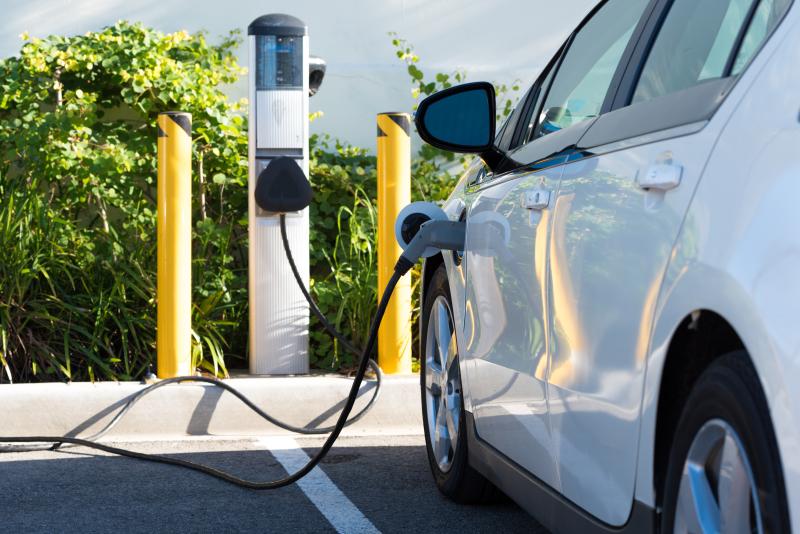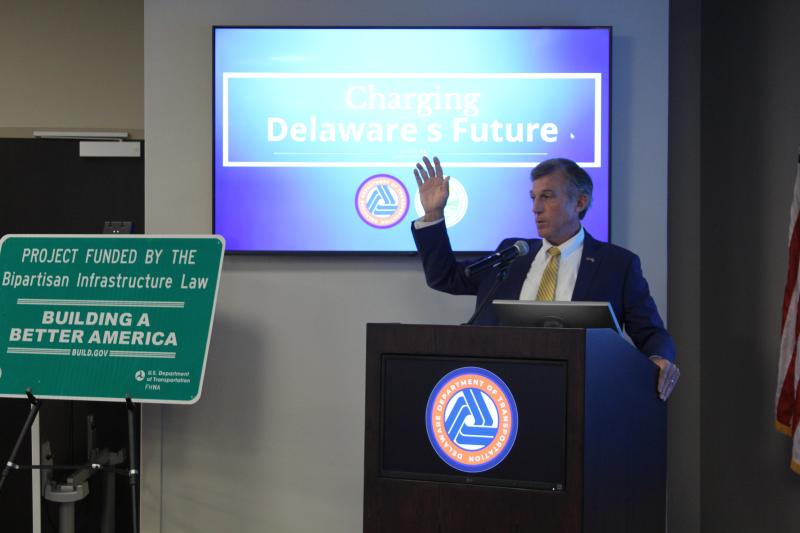Lt. Gov. Bethany Hall-Long said she knows something about range anxiety while driving her electric vehicle.
“As someone on her second EV, I have had white-knuckle syndrome a lot,” she said during a Nov. 1 event at the Department of Transportation to outline investments in the state’s electric vehicle infrastructure.
Using $17.5 million in federal funding and another $4 million in state bond bill money, 10 charging stations will be placed throughout the state. The first two charging stations are planned for Camden and Harrington, and are expected to be operational by the end of 2025.
Delaware’s plan to electrify motor vehicles across the state includes creating a reliable system of charging stations while making sure an infrastructure network is equitable for all users, including rural, underserved and disadvantaged communities.
“The strategy focuses on the planning of the EV charging network to ensure that we are incorporating equity, reliability, and ensuring that the network is connected,” said Stephanie Johnson, director of transportation resilience and sustainability for DelDOT, during a public workshop Oct. 23.
Through a connected charging network, officials hope to alleviate any range anxiety for EV drivers unsure of where the closest charging stations are located, Johnson said.
In 2023, the Department of Natural Resources and Environmental Control adopted California’s Advanced Clean Car II program with some modification.
Instead of requiring all car dealerships to sell only zero-emission vehicles by 2035, the plan is to sell 82% by 2032. The change would start in 2026 with model year 2027, requiring 43% of new cars and trucks sent to Delaware for sale to be zero-emission vehicles. The regulations will expire in model year 2033.
Gov. John Carney announced his commitment to the California emission plan in 2022 as part of the U.S. Climate Alliance. About 30% of greenhouse gas emissions in Delaware come from vehicles, according to the 2020 Delaware Greenhouse Gas Inventory. Electric power accounts for 25%. The 2020 study breaks down the vehicles in the state with about half passenger cars, and the other half made up of heavy-duty vehicles, construction vehicles, and others.
During the Nov. 1 event, Carney said implementing the Climate Action Plan for Delaware is important, but is part of his unfinished business as his governorship approaches its end.
“It’s so hard, and so complicated, it’s going to take a long time,” he said. “It’s probably the biggest challenge that we face.”
Breanne Preisen, Delaware Clean Cities coordinator, said the number of EVs is rising in the state. About 1% of vehicles in 2024 are EVs, and officials hope that increases to 6% – about 60,000 vehicles total – by 2027, and up to 21% or 205,000 EVs by 2032.
There are more than 600 fast-charging ports, she said, across the state, with about 80% of drivers who charge at home. Home charging requires a 110- or 120-volt outlet.
Level II charging is faster and fast charging provides quick charging for those on the go. Charging time for the fast charges is about 30 minutes for a 10-80% charge, according to the digital presentation. More stations continue to be added, Preisen said.
Sabrina Shultz of DNREC said federal infrastructure funding will focus on placing charging stations along Route 1, Route 113, Route 13, and I-95.
“We are placing DC-fast charging stations every 50 miles with the goal of placing them every 25 miles,” she said.
Contracts for fast-charging stations are being finalized, she said, and may take more than a year to complete.
Melissa Steele is a staff writer covering the state Legislature, government and police. Her newspaper career spans more than 30 years and includes working for the Delaware State News, Burlington County Times, The News Journal, Dover Post and Milford Beacon before coming to the Cape Gazette in 2012. Her work has received numerous awards, most notably a Pulitzer Prize-adjudicated investigative piece, and a runner-up for the MDDC James S. Keat Freedom of Information Award.

















































